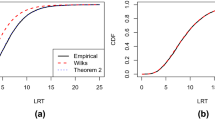Abstract
A two-stage procedure is developed for analyzing structural equation models with continuous and polytomous variables. At the first stage, the maximum likelihood estimates of the thresholds, polychoric covariances and variances, and polyserial covariances are simultaneously obtained with the help of an appropriate transformation that significantly simplifies the computation. An asymptotic covariance matrix of the estiates is also computed. At the second stage, the parameters in the structural covariance model are obtained via the generalized least squares approach. Basic statistical properties of the estimates are derived and some illustrative examples and a small simulation study are reported.
Similar content being viewed by others
References
Afifi, A. A., & Azen, S. P. (1972).Statistical analysis: A computer oriented approach. New York: Academic Press.
Anderson, J. C., & Gerbing (1984). The effect of sampling error on convergence, improper solutions, and goodness-of-fit indices for maximum likelihood confirmatory factor analysis.Psychometrika, 49, 155–173.
Anderson, T. W. (1988). Multivariate linear relations. In T. Pukkila & S. Puntanen (Eds.),Proceedings of the second international Tampere conference in statistics (pp. 9–30). Tampere, Finland: University of Tampere.
Bentler, P. M. (1983). Some contributions to efficient statistics in structural models: Specification and estimation of moment structures.Psychometrika, 48, 493–517.
Bentler, P. M. (1989).EQS: Structural equation program manual. Los Angeles: BMDP Statistical Software.
Bentler, P. M., & Lee, S.-Y. (1978). Matrix derivatives with chain rule and rules for simple, Hadamard, and Kronecker products.Journal of Mathematical Psychology, 17, 255–262.
Bock, R. D., & Lieberman, M. (1970). Fitting a response model forn dichotomously scored items.Psychometrika, 35, 179–197.
Boomsma, A. (1985). Nonconvergence, improper solutions and starting values in LISREL maximum likelihood estimation.Psychometrika, 50, 229–242.
Browne, M. W. (1974). Generalized least-square estimators in the analysis of covariance structures.South African Statistical Journal, 8, 1–24.
Browne, M. W. (1982). Covariance structures. In D. M. Hawkins (Ed.),Topics in applied multivariate analysis (pp 72–41). Cambridge: Cambridge University Press.
Browne, M. W. (1984). Asymptotically distribution-free methods for the analysis of covariance structures.British Journal of Mathematical and Statistical Psychology, 37, 62–83.
Browne, M. W. (1987). Robustness of statistical inference in factor analysis and related models.Biometrika, 74, 375–384.
Christoffersson, A. (1975). Factor analysis of dichotomized variables.Psychometrika, 40, 5–32.
Corbin, B. C., & Lindsey, R. (1985).Concepts of physical fitness (5th ed.) Dubuque, Iowa: Wm. C. Brown.
Ferguson, T. S. (1958). A method of generating best asymptotically normal estimates with applications to the estimation of bacterial densities.Annals of Mathematical Statistics, 29, 1046–1062.
Fu, F. H., & Chan K. M. (1987).Synopsis of sports medicine and sports science, Hong Kong: The Chinese University of Hong Kong Press.
Johnson, N. L., & Kotz, S. (1972).Distributions in statistics: Continuous multivariate distributions. New York: Wiley.
Jöreskog, K. G., & Sörbom, D. (1988a).PRELIS: A preprocessor of LISREL. Mooresville, IN: Scientific Software.
Jöreskog, K. G., & Sörbom, D. (1988b).LISREL 7: A guide to the program and application. Mooresville, IN: Scientific Software.
Lee, S.-Y. (1981). The multiplier method in constrained estimation of covariance structure models.Journal of Statistical Computation and Simulation, 12, 247–257.
Lee, S.-Y., & Bentler, P. M. (1980). Some asymptotic properties of constrained generalized least squares estimation in covariance structure models.South African Statistical Journal, 14, 121–136.
Lee, S.-Y., & Jennrich, R. I. (1979). A study of algorithms for covariance structure analysis with specific comparisons using factor analysis.Psychometrika, 44, 99–113.
Lee, S.-Y., & Poon W.-Y. (1986). Maximum likelihood estimation of polyserial correlations.Psychometrika, 51, 113–121.
Lee, S.-Y., Poon, W.-Y., & Bentler, P. M. (1990a). A three-stage estimation procedure for structural equation models with polytomous variables.Psychometrika, 55, 45–52.
Lee, S.-Y., Poon, W.-Y., & Bentler, P. M. (1990b). Full maximum likelihood analysis of structural equation models with polytomous variables.Statistics and Probability Letters, 9, 91–97.
McDonald, R. P., & Swaminathan, H. (1973). A simple matrix calculus with application to multivariate analysis.General Systems, 18, 37–54.
Mislevy, R. J. (1986). Recent developments in factor analysis of categorical variables.Journal of Educational Statistics, 11, 3–31.
Muthén, B. (1978). Contributions to factor analysis of dichotomous variables.Psychometrika, 43, 551–560.
Muthén, B. (1984). A general structural equation model with dichotomous, ordered categorical, and continuous latent variable indicators.Psychometrika, 49, 115–132.
Muthén, B. (1987).LISCOMP: Analysis of linear structural equations using a comprehensive measurement model. Mooresville, IN: Scientific Software.
Olsson, U., Drasgow, F., & Dorans, N. J. (1982). The polyserial correlation coefficient.Psychometrika, 47, 337–347.
Poon, W.-Y., & Lee, S.-Y. (1987). Maximum likelihood estimation of multivariate polyserial and polychoric correlation coefficients.Psychometrika, 52, 409–430.
Satorra, A., & Bentler, P. M. (1990). Model conditions for asymptotic robustness in analysis of linear relations.Computational Statistics & Data Analysis, 10, 235–249.
Schervish, M. J. (1984). Multivariate normal probabilities with error bound.Applied Statistics, 33, 81–94.
SPSS (1988).SPSS-X user's guide (3rd ed.). Chicago, IL: Author.
Wilk, M. B., & Gnanadesikan, R. (1968). Probability plotting methods for the analysis of data.Biometrika, 55, 1–17.
Author information
Authors and Affiliations
Additional information
This research was supported in part by a research grant DA01070 from the U. S. Public Health Service. We are indebted to several referees and the editor for very valuable comments and suggestions for improvement of this paper. The computing assistance of King-Hong Leung and Man-Lai Tang is also gratefully acknowledged.
Rights and permissions
About this article
Cite this article
Lee, SY., Poon, WY. & Bentler, P.M. Structural equation models with continuous and polytomous variables. Psychometrika 57, 89–105 (1992). https://doi.org/10.1007/BF02294660
Received:
Revised:
Issue Date:
DOI: https://doi.org/10.1007/BF02294660




